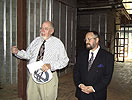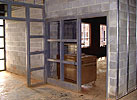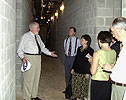Glaxo Gives Grant To Healing Place
City Leaders Get Glimpse of New Facility
The Healing Place of Wake County recently kicked off a $7.5 million campaign to raise funds for operating expenses, to provide the capital to build a women’s facility, and to form an endowment to fund future operations. On Thursday, September 14, Glaxo Wellcome announced a $500,000 grant to help start the endowment.
 The event also afforded the Healing Place an opportunity to take city leaders and members of the press on a tour of the future home of this residential recovery and support program for homeless men with substance abuse problems.
The event also afforded the Healing Place an opportunity to take city leaders and members of the press on a tour of the future home of this residential recovery and support program for homeless men with substance abuse problems.
| Glaxo’s Senior VP of Corporate Affairs Margaret Dardess was on hand at the Thursday press conference at the front steps of the facility. She stated that, “The Healing Place will offer a real chance to stop the cycle of drug and alcohol dependence. . . .We [at Glaxo] are convinced The Healing Place will go a long way toward improving this community and the quality of life for us all.” President of the Healing Place Board Fred Barber said, ”[the Glaxo grant] is a terrific launch to the campaign.” |
 Margaret Dardess Margaret Dardess
Glaxo’s Senior VP of
Corp Affairs |
 The facility is nearing completion and Barber announced that they are on budget and ahead of schedule. Originally slated to open in February 2001, the center will actually open its detox and shelter wing during Christmas week this year. The administrative and residential wings will open on February 1, 2001. The shift in opening is a significant boost for the center because these homeless are most likely to seek help for their addictions around the Christmas holidays and when the weather is cold.
The facility is nearing completion and Barber announced that they are on budget and ahead of schedule. Originally slated to open in February 2001, the center will actually open its detox and shelter wing during Christmas week this year. The administrative and residential wings will open on February 1, 2001. The shift in opening is a significant boost for the center because these homeless are most likely to seek help for their addictions around the Christmas holidays and when the weather is cold.
| The 41,000 square foot facility will be the home of a “recovery dynamics program” that promotes interaction all the time between the men in the program. The three wings form a horseshoe around a private courtyard. The left wing will contain an emergency detox center, cafeteria, laundry facility, and an off-the-street shelter. The middle wing will house the administrative offices, a chapel, the community room, and two classrooms. The right wing, the residential area, |

The detox wing of the center will open ahead of schedule, during the week of Christmas this year. |
will contain varying levels of living quarters from dormitory-like rooming to motel-like rooms for those further in the program.
Participants can enter the program through the detox center or through the homeless shelter. They must remain drug and alcohol-free at the onset of the program, and then progress through various phases after making a contract with the Healing Place. The program is based on perks and incentives, which are given by the members of the Healing Place community, not the staff. The men in the program will be responsible for maintaining the facility. From security, to kitchen duties, to teaching classes, the program participants will have ownership over their own recovery.
| Executive Director Dennis Parnell said, “The community takes care of its own. It is really is an amazing thing to see. People will rise to the level of responsibility given them.” The facility can house up to 165 men, men who will spend 6 to 9 months in recovery and leave as tax-paying, self-supporting citizens. Program participants will learn skills to help them beat their habits and seek employment outside the walls of the Healing Place. The buildings are utilitarian but attractive. As the Healing Place Board’s VP Barbara Goodmon said, “If we don’t have any expectations, why should they?” |
 Dennis Parnell Dennis Parnell
Executive Director |
The program does work, as evidenced by the model program in Louisville, Kentucky, on which this center is based. The Healing Place of Wake County will hopefully serve as a model for North Carolina and encourage other counties to follow suit.

A.J. Fletcher Foundation Board member Barbara Goodmon serves as Vice President for the Healing Place Board and has been instrumental in getting the program going. |

Barber joins Healing Place Executive Director Dennis Parnell in outlining the benefits of the rehab program. |

The administrative offices will house the approximately 22 HP staff members. |

Barber shows where the off-the-street phase of the program will be housed. Participants will begin the program by staying drug and alcohol free for two weeks. |

The detox center will have 26 beds and a community bathroom. Clinically trained staff will monitor patients as they begin the drying out process. |

Barber explains that those who advance to these two-occupant rooms are nearing the end of the program. |

Residents will undergo intense education. This classroom is one of two in which program participants will learn about the mechanics of their addictions |

The cafeteria, in the detox wing, can accommodate 300 men and will have a “teaching” kitchen where residents can learn skills to get jobs in the community. |

Healing Place Board President Fred Barber leads a tour through the residential wing. |